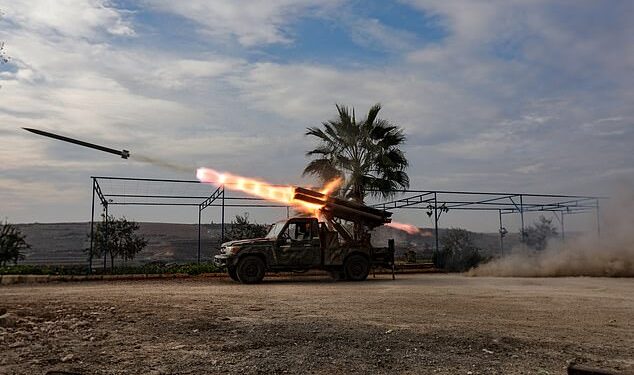Islamist-led rebel forces have captured yet another city in Syria, overrunning Assad’s forces in the city of Hama as the insurgents continue their surprise offensive.
The rebels led by the Islamist group Hayat Tahrir al-Sham (HTS) stormed the city of just under a million people and, after fierce fighting, claimed to have seized its prison and released inmates.
After a night of violent clashes, the rebels entered Hama ‘from several sides’ and were engaged in street fighting with Assad’s forces, said the Syrian Observatory for Human Rights war monitor, a British organisation.
By early Thursday afternoon, Syria’s army admitted it had lost control of the strategically located city seen as crucial in its efforts to protect the capital and seat of power, Damascus.
‘Over the past few hours, with the intensification of confrontations between our soldiers and terrorist groups… these groups were able to breach a number of axes in the city and entered it,’ the army said, adding units had redeployed outside the city.
The fall of Hama came despite shelling and strikes carried out by the Syrian and Russian air forces, as reported by state media late Wednesday.
Maya, a 22-year-old student who gave only her first name for security concerns, said she and her family were staying at home as the fighting rages outside.
‘We have been hearing non-stop the sounds of explosions and shelling,’ she told AFP by telephone from Hama.

A multi-barrel rocket launcher fires against regime forces, in the northern outskirts of Syria’s west-central city of Hama on December 4, 2024

Anti-government fighters rest at a position in the northern outskirts of Syria’s west-central city of Hama on December 4, 2024

A Syrian Kurdish woman, fleeing from north of Aleppo, stands leaning on a bullet-riddled wall upon arriving in Tabqa, on the western outskirts of Raqa, on December 4, 2024
‘We don’t know what’s going on outside.’
The Observatory, which relies on a network of sources in Syria, says 727 people, mostly combatants but also 111 civilians, have been killed in Syria since the violence erupted last week.
It marks the most intense fighting since 2020 in a country already ravaged by civil war, which erupted with the repression of pro-democracy protests in 2011.
Key to the rebels’ successes since the start of the offensive last week was the takeover of Aleppo, which in more than a decade of war had never entirely fallen out of government hands.
The head of HTS, Abu Mohammad al-Jolani, on Wednesday visited Aleppo’s landmark citadel.
Jolani was seen waving to supporters from an open-top car as he visited the historic fortress, in images posted on the rebels’ Telegram channel.
While the advancing rebels found little resistance earlier in their offensive, the fighting around Hama has been especially fierce.
Assad ordered a 50-percent raise in career soldiers’ pay, state news agency SANA reported, as he seeks to bolster his forces for the counteroffensive.

A Syrian Kurdish woman, fleeing from north of Aleppo, waits on a street with a child upon arriving in Tabqa, on the western outskirts of Raqa, on December 4, 2024

An anti-government fighter carries a rocket to be used against regime forces, in the northern outskirts of Syria’s west-central city of Hama on December 4, 2024

The rebels launched their offensive in northern Syria on November 27, the same day a ceasefire took effect in the war between Israel and Hezbollah in neighbouring Lebanon
Syrian armed forces were driven back by the rebels despite the government sending in ‘large military convoys’, according to the Observatory.
The monitor said the fighting on Wednesday was close to an area mainly populated by Alawites, followers of the same offshoot of Shiite Islam as the president.
The rebels launched their offensive in northern Syria on November 27, the same day a ceasefire took effect in the war between Israel and Hezbollah in neighbouring Lebanon.
Both Hezbollah and Russia have been key backers of Assad’s government, but have been more recently mired in their own respective conflicts.
The United Nations on Wednesday said 115,000 people had been ‘newly displaced across Idlib and northern Aleppo’ by the fighting.
Human Rights Watch warned the fighting ‘raises concerns that civilians face a real risk of serious abuses at the hands of opposition armed groups and the Syrian government’.
Until last week, the war in Syria had been mostly dormant for years, but analysts have said violence was bound to flare up as it was never truly resolved.

Armed groups, opposing the Bashar al-Assad regime, continue their advance as they have captured 20 more settlements in the western province of Hama, Syria on December 4, 2024

Military reinforcements are on the way from Idlib to control the Hama fronts as armed groups, opposing the Bashar al-Assad regime, have captured 20 more settlements in the western province of Hama, Syria on December 4, 2024

Smoke rises as a member of the rebels led by the Islamist militant group Hayat Tahrir al-Sham drives on a motorbike in al-Rashideen, Aleppo province, Syria November 29, 2024
Spearheading the rebel alliance is HTS, which is rooted in Syria’s Al-Qaeda branch.
‘HTS has had a lot of time and space and resources to organise itself and to prepare for this,’ said analyst Sam Heller, of the US-based Century Foundation think tank.
How the fighting unfolds now ‘depends on whether the Syrian government can regain its footing’, Heller said.
‘Opposition forces currently pushing south will likely get stuck somewhere in Syria’s centre, when they run into really motivated and intractable loyalist resistance,’ he said.
‘At that point, it will be a question of whether Damascus has the means to mount the type of scorched-earth counteroffensive I assume it would like to execute.’







